A difficult week, but we have a newsletter, which, in calmer times, will be expanded. And it turned into rather a celebration of aviation as well, must be something in the air!
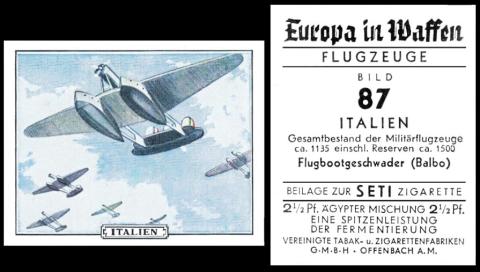
VEREINIGTE Tabak- u. Zigarettenfabriken G.m.b.H. [tobacco : O/S - Offenbach am Main, Germany] "Europa im Waffen" / Europe in Arms (1938) 87/180 - V17-1
Lets start the week off with a centenary, as today in 1925 the Ministry of Aeronautics was founded, as an equal to the Ministries of War and the Navy. It covered both civil and miltary aviation, hence the "aeronautics" in the title.
Italy`s air force technically began in 1912, but it was not a stand alone department, and at the end of the First World War it found itself part of the Ministry for Sea and Railway Transport. It only became a separate body, the Ministry of the Air Force, today in 1925, and it also took on anything related to military flying, which had formerly been part of the Ministry of War. Its first Minster of the Air Force was Benito Mussolini, and it was he who employed Italo Balbo as his undersecretary in 1926. Then, in 1929, Italo Balbo became the Minister of the Air Force. However it was a short tenure, as Mussolini took it back in 1933 and remained in charge for almost ten years.
As for Italo Balbo, he was once slated to replace Mussolini in event of assassination or death. Unfortunately, he died first, in June 1940, when his aeroplane was shot down over Tobruk by the Italian forces, who claimed that they had mistaken his aeroplane for an enemy craft. However he was not popular with the people in power, and directly opposed Mussolini`s alliance with Adolf Hitler - and there are lots of theories that the shooting was hardly an accident, more a case of silencing, permanently, someone who was both charismatic, well loved, and well listened to by the general Italian public.
This card commemorates one of his most famous exploits, when, on the first of July 1933, he was in charge of a formation flight of twenty-four Savoia Marchetti S.55X flying boats that flew right from Italy to Chicago - the largest formation of craft ever to cross the Atlantic in strict formation - a feat which took forty-eight hours.
After the Second World War, with the Kingdom of Italy no more and an Italian Republic in place, the Ministry remained in charge of both civil and military aviation, and it also still remained as "Aeronautics", though across the world it is known as the Italian Air Force.
Now a lot of collectors cite this set as having been circulated by Borg, but it was actually produced by an alliance of manufacturers, of which Borg was only one. The word "Vereinigte" actually means united, or allied.
It therefore appears in our original World Tobacco Issues Index as :
- VEREINIGTE Tabak- u. Zigarettenfabriken G.m.b.H., Offenbach, a.m. Germany.
Association of manufacturers, including Borg. German language issue, period 1928-1942.
EUROPA IM WAFFEN (Europe in Arms). Md. 60 x 50. Nd. (180) ... V17-1
Now there are a few things here to clear up. The first is that the town name was Offenbach am Main. The second is that the date of 1928 must be wrong, firstly because issuing the same set for almost fifteen years would not have enhanced sales, but also because the set deals with the Second World War, and it seems to be that the easiest way to rectify the date is to change the 1928 to a 1938.
In fact whilst I was hunting this information I found a really amazing resource called ZIGSAM, the text is in German,but they list that in 1937 a lot of cigarette companies closed, including Borg. In the same breath, and in that same year, they also speak of two companies being founded, Vereinigte Zigarettenfabrik and Vereinigte Tabak und Zigarettenfabriken, both at Berlin, The first one was just for cigarettes and the second one was tobacco and cigarettes. And this new information also points to these cards being actually issued in 1938.
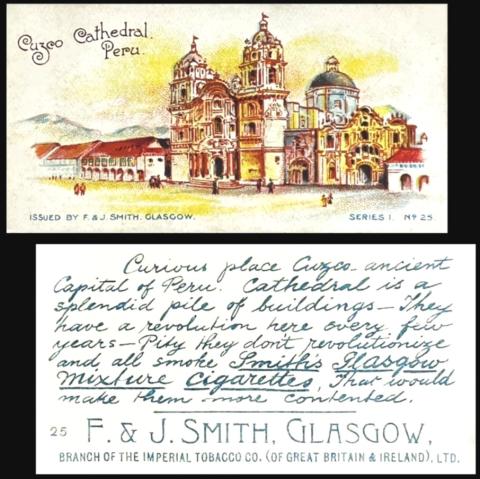
F. & J. Smith [tobacco : UK - Glasgow, Scotland] "A Tour Round The World" - - without series title, script back (1904)
Centenary number two sees another feat of aviation, for today in 1925 Alejandro Velaso Astele became the first person to fly over the Andes mountains.
Now you may not think our card very suitable, for the Andes are but a backdrop on it - however Senor Astete was born in Cusco, the town on this card, on September the 28th, 1897, and it was here that he landed that aeroplane after this monumental flight. More than that though, he called his aeroplane "Cusco". And I am delighted to report that the town still remembers him too, with their Alejandro Velasco Astete International Airport, a monument, and also the name of a street that runs close by.
Sadly little is known about the man behind the feat, only that he had gone to the School of Engineering in Lima and was talented enough to be sent to Argentina as an apprentice. However he wanted to fly, not build.
He joined the Aviation School of Peru, and then he became a military pilot during the First World War. Almost certainly, like a lot of aviators, once the war was over, he was bored, and missed the flying and the camaraderie. Many took up stunt flying, with ever more elaborate feats, whilst others tried to fly further and faster than anyone had ever done before.
After our man took off from the Las Palmas Field in Lima, on the 29th of August, 1925, his heart must have soared, and he successfully crossed the Andes. However the weather was bad that day, and he did not make the whole journey, landing instead at Pisco.
On the 31st of August, the weather was better, and he decided to continue. It is recorded that this leg of the journey took almost four hours, probably why he stopped off at Pisco. On arrival, and for some time after, people were all speaking of him, coming up and shaking his hand, excited that a local flier had been the first to tackle the treachery of those far off mountains.
He intended to rest, but he had an invite to visit Puno. And so he set off for there on the twenty-eighth of September. It was a two hour trip, and there was lots of publicity, so much so that the landing field was thronged with crowds, so much so that he could hardly see where he was going to land. He kept flying, then turned and came round for a second attempt, but his aeroplane crashed, and when the crowds arrived, they found him dead.
He was just 28 years and five days old.
This is a complex set, in three different parts. The first of these has exactly the same fronts as our card, but the backs of those look like a postcard, complete with a message on one side and an address, plus a printed stamp, complete with postmark. on the other. You can see one of these as our Card of the Day for the 7th of October 2024.
Our card falls into the second group, 1.B, which appears in our original World Tobacco Issues Index as :
A TOUR ROUND THE WORLD. Sm. Nd. ... S84-16
1. Without Series Title (50). Vari-backed, 12 wordings - see C.C.N. Vol.21, page 67.
B. Back with handwritten advertisements, with I.T.C Clause. Numbered front and back.
By the way, the wording is exactly the same on these two sets as well, but whilst the postcard version contains it all to the message section, on our version it extends right across the back, and is followed by the card number, and "F. & J. Smith, Glasgow / Branch of the Imperial Tobacco Co. (of Great Britain and Ireland), Ltd.".
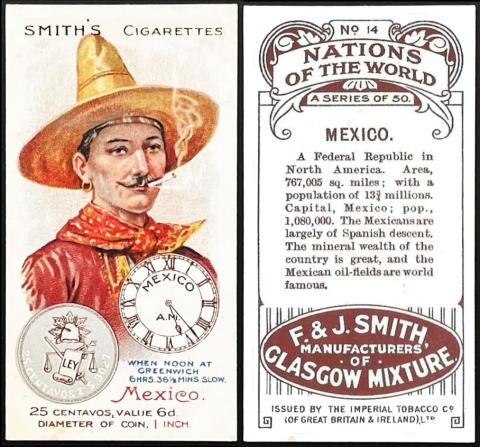
F. & J. SMITH [tobacco : UK - Glasgow, Scotland] "Nations of the World" (1923) 14/50 -
Today we have our third centenary in as many days. This celebrates the Banco de Mexico, which officially began operations today, though it had technically existed since August the 25th.
The first idea of a central bank for Mexico seems to have been discussed in the 1820s. It was to be known as The Great Bank of the Mexican Empire, but there were problems. Mexico had been subject to internal and external wars, right up to the Mexican Revolution of 1910 - and at times of war, the people tended to believe that their money was safer and easier to get it if it was kept at home. There were banks, but they were regional, and to be honest they were fighting a losing battle with the general public, who tended not to like someone else keeping their money out of sight, preventing it from immediate use, and also they were distrustful of revealing how much money they had amassed, in case it was removed.
It took until 1917 to come up with the idea of a central bank for the whole of Mexico. At first the people felt this was an even worse idea than putting money in a local bank. Things became a little calmer when it was published that the bank would be under control of the government, though a lot of Mexicans distrusted them. And there was hardly any money in the treasury, whereas the whole idea of a bank relied on people paying in money and the bank using it to make more money. Not having enough money coming in would almost certainly be unprofitable for the bank, and disastrous if people came in to withdraw their money only to find they could not.
It is doubtful there would ever have been a Bank of Mexico at all if there had not been a League of Nations, for one of their ideals was to have a central bank in every country that they had influence over. Once they were on board, the idea seemed to gain support, though the majority of the funds which, at first, propped it up, were deducted from the Army budget.
With the opening of the bank, standardisation came along. They were the only people which could legally mint and circulate currency, both coins and notes, and they also set the interest and exchange rate, both of which formerly varied from town to town.
As for the coin on our card, that predates the Bank of Mexico - it comes from the Federal Republic period of 1823 to 1905, though it was only in circulation between 1869 and 1892. It was also made of silver, The front shows an eagle, perched on a cactus, with a snake in its beak, and the lettering around the edge is "Republica Mexicana". Whilst the reverse is a cap, emitting shining rays of light, above a set of weighing scales, and a piece of paper, rolled as a scroll, that says one word "LEY". That word means law, but it also has a subtext, that the coin is lawful, and genuine.
This set is another one which has several issuers. The main one of these is W.D. & H.O. Wills, who issued it first of all, in 1907, overseas, in Australia, variously branded for `Capstan`, `Havelock`, and `Vice-Regal`, the last of which was actually issued twice, with and without a mention of the special album in which to house the cards. We do not know a month of issue, for it was never recorded by Wills, which usually means the set was printed overseas by a local company, rather than being printed in house and shipped over as complete cards. It was not until April 1908 that it appeared in packets within the United Kingdom.
Curiously, this set was also issued in 1908, as a trade issue by Fry, with chocolate.
Our Smith issue came along a very long time after, in October 1923, and it is the only version which has a different title, all the rest being called "Time and Money". It was also exactly the same as the other issues, save the name on the top of the front of the card - and we know that because card 11 is entitled "Indian Territory", and that no longer existed, having been replaced by the new name for that state, Oklahoma. In fact Oklahoma was created in 1906, just one year before the original Wills` Australian issues - and there is a suspicion that it appears in that set simply because of its topicality.
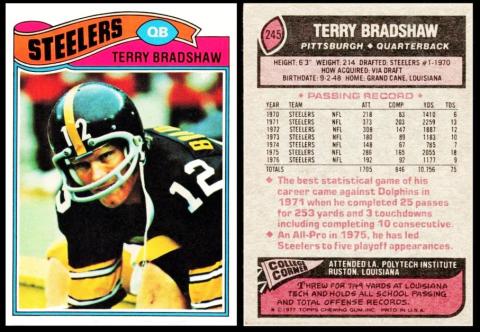
Topps [trade : bubble gum : O/S - USA] "Football" (1977) 245/528
Now we break with our centenaries, and have a chat about Terry Paxton Bradshaw, showing here.
He was born today, the second of September, 1948, in Shreveport, Louisiana, America, and played football for the first time at high school. He was expected to go to Louisiana State University, but chose instead to go to Louisiana Tech, in Ruston, which was closer to his home. In hindsight, this was a good move, for he was far and away their best player, and that led him to the attention of the Pittsburgh Steelers, which is the team on our card. For if he had gone to the State University, there would have undoubtedly been players of a similar ability, maybe even better, and he may not have shone so bright amongst them.
He joined the Pittsburgh Steelers in 1970, and within a year he was their full time starting quarterback. He also led them to four Super Bowl wins, for the two consecutive years of 1975 and 1976, and then again in 1979 and 1980.
He retired in 1983, but kept his love of football, and found a second career commentating and analysing the sport on television. He also became an actor, when it suited him, and he often turned up as a one-off guest star in several long running serials - and films, including "Smokey and the Bandit" and "The Cannonball Run".
If that were not enough, he also sings, mostly country music.
This card brings up a quandary, as we also have a Topps "Football 77" here in the United Kingdom, showing soccer. You can read all about that elsewhere on this site, as it was featured as the Card of the Day for the 31st of December 2022 - and there is a sub set, "Shoot! Goal All Stars", which is also featured as a Card of the Day, on the 3rd of July, 2023.
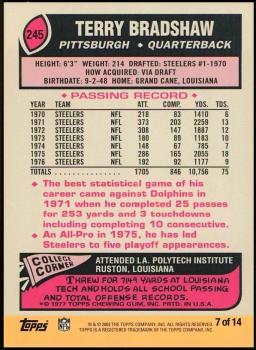
As for the American version, there are also variations to collect, including one issued in Mexico.
Then there are two known checklists, one with a brown back, which was the one you got in the packet with the bubble gum, and one with a white back, which was returned to the collector after taking part in the mail-in exchange offer.
There is another variant too, for this set was re-released by Topps in 2002. There is an easy-to spot difference though, as you can see on this image - the reprints having a large orange slab at the base, in which is the Topps logo and the date. Also it is impossible to cut this off, as the front of the reprint is exactly the same as our featured card above, the card is full front, without a slab. Full marks to Topps for that one.
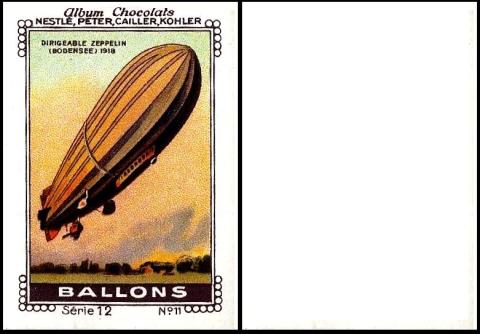
Nestle, Peter, Cailler, Kohler [trade : chocolat : O/S Switzerland] "Ballons" - serie 12 (1920) 11/12
Now this picture is not the subject of today`s diary date, but it was a similar craft. For today in 1925, in another centenary event, the USS Shenandoah, which is stated to be "a Zeppelin derived airship" crashed.
Actually there is more to those words than I realised before I started researching, as the USS Shenandoah was not derived, but directly copied from a Zeppelin, the L-49, which was actually one of a pack of thirteen ships which raided England on the morning of Oct. 19, 1917. However, on the way back, it was forced down by French fighter aircraft, and captured, almost undamaged, by Allied forces.The crew all survived, and were taken prisoner.
In fact this craft was also used as reference for the British airship, the ill fated R.38, which broke up and exploded on its fourth trial flight in July 1921, with the loss of forty-four lives.
Returning to the USS Shenandoah, this was the first of four rigid bodied airships designed for the United States Navy. It was built between 1922 and 1923, first flying in the September of that year. It also has a big claim to fame, as it was the first airship to fly the whole way across North America, in October 1924. And it was also the first rigid airship to be powered by helium.
On the second of September 1925, the craft embarked on a promotional tour, across to the Midwest, where it had a packed schedule of fly-overs, both cities and state fairs, and some scheduled landings at the latter. However, whilst in flight, on the morning of the third of September, the ship fell to earth in three pieces near Caldwell, Ohio. Fourteen people on board were also killed, though twenty-nine survived.
Efforts at finding out what had happened were severely hampered by sightseers, who stripped the site for souvenirs, including personal belongings from the crew. Today, reconstructions have proven that despite mechanical failure being blamed at the time, the reason for the crash was mostly coincidental, their course went through a huge storm, and the ship, badly affected by wind and pressure, was driven up to an altitude that it was never designed to reach. And the airship was torn apart, before it ever hit the ground.
Now I could not find any cards of the USS Shenadoah, but maybe you have one. And if so perhaps you would like to share it here....?
This set was issued in several variations, which are :
- Nestle`s Chocolats au Lait (at bottom) - "Ballons" at top - Serie VI
- Peter, Cailler, Kohler, Nestle (at top) "Ballons" at bottom - Serie XII
The ballons, or balloons featured are
- Pilatre de Rozier in 1703 - premiere Montgolfiere avec aeronautes
- Aero-Montgolfiere 1785 Pilatre de Rozier
- Traversee du Canal de la Manche 1785
- Aero-Flotille (Paris) 1894
- Ballon "Aero-Club" 1900
- Dirigeable Giffard 1852
- Dirigeable Renard & Krebs 1884
- Dirigeable Santos-Dumont 1904
- Dirigeable de L`Armee Italienne 1900
- Dirigeable Zeppelin 1900
- Dirigeable Zeppelin (Bodensee) 1918 - our card
- Dirigeable Anglais "R.33" 1919
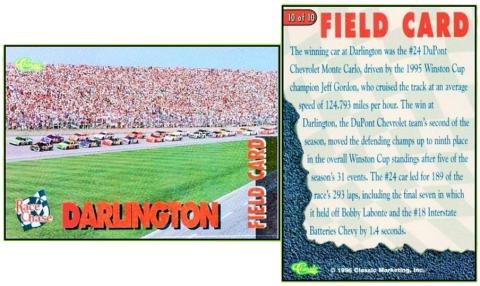
CLASSIC Racing [trade/commercial : cards : O/S - USA] "Race Chase" (1996) 20/20
Now today`s subject is not a centenary, but it is the seventy-fifth anniversary of the first Southern Five Hundred, NASCAR`s original super-speedway race, and the first for "stock cars", which does not mean the crash, bang, wallop demolition Derby`s that we have in the United Kingdom, it means a car which is pretty much a production car, unlike a Grand Prix or an Indy Cart vehicle, which is all souped up and lowered.
The field, or the number of cars that raced all at once around the circuit, at this first event was quite big, seventy-five cars. And it attracted twenty-five thousand fans. And the race also went down in the record books because the winner had been last on the grid, the slowest car to qualify, who had a secret weapon and used truck tyres rather than car ones - so whilst other drivers had to replace their worn out or even blown tyres he just kept on driving.
The track was also rather special, and purpose built in 1950. It was a mile and a quarter long, with banking that rose from the level ground at the centre to some twenty-five feet above. This was a great way for the cards to gain speed, and also it looked pretty spectacular for the fans. However in the record books it states that there were only ten thousand sets, so what the other fifteen thousand spectators did, who knows.
This is actually from "Race Chase", a sub set of the main fifty card set which has come to be called "Classic Racing", after the maker, Classic, rather than an age. That set has forty-eight cards of teams, and two cards, numbers 10 and 50, which shows the entire field.
The other sub-sets, as issued in the packets, were a "Image Preview", an "Inner View", "Mark Martin`s Challengers", and "Winston Cup Champion".
As well as these there were three mail-in sets, two of which were "Race Chase" cards for the Darlington Prize and the Daytona Prize, and one of which was a chance to win a phone card, preloaded with $50.
And if that were not enough, you can get the entire base set with a silver finish, or as printer`s proofs.
There were also two promo cards, both showing Dale Earnhardt.
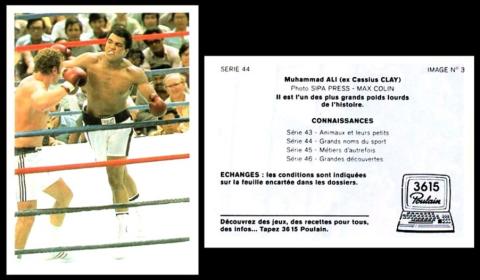
Chocolat POULAIN [trade : chocolate : O/S - France] "Grands noms du Sport" / Big names in Sport - S.44 (19??) 3/
Today in 1960 saw this man, Cassius Marcellus Clay, Junior, win an Olympic Gold medal.
Amazingly, there were ten weights competed at the 1960 Summer Olympics - Bantamweight, Featherweight, Flyweight, Heavyweight, Light Heavyweight, Light Middleweight, Lightweight, Light Welterweight, Middleweight, Welterweight.
It was in the Light Heavyweight class that our man won his medal, beating Zbigniew Pietrzykowski of Poland. The class was for boxers weighing between seventy-five and eighty-one kilograms but above.
However, our story begins long before that, with Cassius Marcellus Clay, born in 1810, a planter who became a politician, becoming heavily involved in the abolitionist cause. Not just that but he founded the Republican party in his native Kentucky, and impresses President Abraham Lincoln so much that he made him the U.S. Ambassador to Russia. He was not a blood relation to our man`s family, but our man`s father was named after him, to celebrate his stand against slavery, and he passed the honour to his son, simply adding the junior.
Later on, after he converted to Islam in the mid 1960s, our Cassius Clay saw the connection in another way, and considered it a lasting reminder of slavery - and so he changed it, to Muhammad Ali.
His strong convictions also affected his career, as he was a conscientious objector, and refused to join the forces during the Vietnam War, and that resulted in him being banned from international boxing until 1971. His next fight was against Joe Frazier, for the Heavyweight title which had been stripped from Muhammad Ali, as well as the enforcement of the ban. This was known as the fight of the century. and it took place at Madison Square Garden in New York, but in the fifteenth round Muhammad Ali was knocked down and Joe Frazier was given the fight.
He retired in June 1979, but came back the following year to go against Larry Holmes, again for the Heavyweight championship. This lasted just eleven rounds and ebded with a knockout in Holmes` favour. He had a couple more fights but then hung up his gloves for good.
In 1984 he was diagnosed with Parkinson`s disease, aged just forty-two, and he lived with it until 2016. One very interesting thing was that he decided not to withdraw from the world, he wanted people to see that the disease was not something to be hidden away, and that it could affect everyone, whoever they were.
This week's Cards of the Day...
We are a bit early, but this week we are going to look forward to September and add a few more cards to our gallery that were issued in that month.
Actually there is a lot of those, starting with F. & J. Smith`s "A Tour Round The World" (the postcard back version), which was issued in 1905. Two other sets were issued in the September of that year as well. One was Wills` "Medals", issued overseas - which we have not yet featured, though it is the same set as was issued in the U.K. by Churchman, Imperial Tobacco, and F. & J. Smith. Whilst the other was Wills "Nelson Series" [which is a newsletter card, so just scroll down to Friday 15 September to see it.]
As for the last card on the list, that is Brooke Bond`s "Asian Wildlife" issued in September 1962.
The year which saw the most September sets issued was a tie, with seven sets each being issued in September 1935 and 1936. The runners up were 1914, 1926, and 1928, each of which saw five sets issued. I will not give the sets, as you can look those up for yourself in our research blog under the section called A Cartophilic Year.
Now I have left the most curious September set to last, and that is a set called "Art Hangers". This appears in our original Wills reference book part five, as follows :
382. UNTRACED SERIES. Under this heading are listed the Overseas Issues bearing Wills` name or a Wills brand name, included in a report received from the British American Tobacco Co., Ltd., but of which no cards have yet been traced.
C. Art Hangers. Series of 50, stated to have been issued with "Ruby Queen" Chinese backs in September 1927.
This set does not appear in the original, nor the updated World Index under the "Ruby Queen" section, and there is no untraced series section either. So can anyone out there explain to where it went?
As for our clue cards, they were ...
Saturday, 23rd August 2025
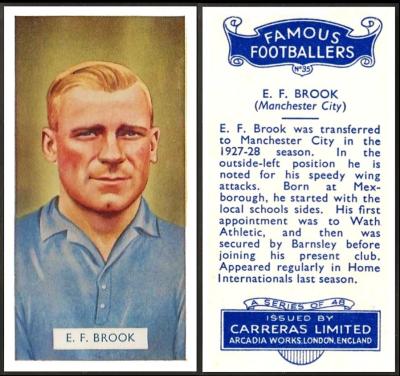
The first "September - issued" card of the week was this one, and I was delighted to acquire it, because we have already featured this very card, but it was issued twice. Now the reference books say that the second version was "redrawn", but I did not realise how spectacularly redrawn this card was. And you can see that for yourself, because we used the other version as our Card of the Day on the 16th of March 2024. And you will also find a biography of this player on that site.
In fact you can see all the "redrawn" cards courtesy of the Football Cartophilic Info Exchange/CFFR.
Now we know that the set was issued, originally, in September 1935, and the redrawing came later, which can plainly be seen on that page, as everyone looks older! So it may indeed be the case that the two cards swap places on our website, and the original, September, one comes here whilst this set is sent off to illustrate the word "Brook".
Our original World Tobacco Issues Index describes the pair as :
- FAMOUS FOOTBALLERS, Sm. Nd. ... C18-43
A. Nos. 1/48 with caption panel on front 3 m/m deep (48)
B. Nos. 25/48, subjects redrawn, caption panel 4 m/m deep (24).
The text is exactly the same in our updated version of that book, except for a new card code, of C151-250
Sunday, 24th August 2025
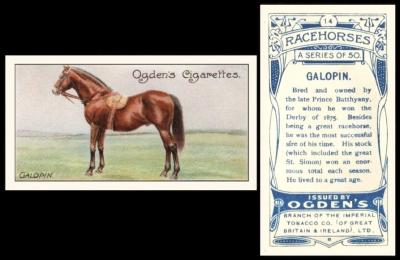
The teaser this time referred to the fact that of these fifty horses, the one shown as today`s card is the only one wearing a saddle. There is another possible answer, as it looks like he is the only horse in the set whose name was used for a railway locomotive, on the L.N.E.R, network, right from 1925 until 1962.
Galopin was foaled in 1872. He started racing as a two-year-old, and only ran for just over one year, fitting in nine races, eight of which he won, including the 1875 Derby. However, at the end of 1875, he was retired from racing and sent to stud, which I have to say he probably enjoyed a lot better..
He was quite small for a racehorse, just 15.3 hands high. However he supposedly had great parentage, his father, Vedette, winning the 2,000 Guineas. However Vedette had a long career, and got worn down, being sold for hardly nothing at auction at the age of seventeen. I can but hope he ended his days as a companion, or a riding horse, pottering gently about with a caring, gentle owner, and lots of sugar lumps - but I will not look it up in case I am wrong.
By the way, the word "supposedly" is there for good reason, as recent research into genetics has suggested that our horse is unlikely to have been fathered by Vedette. There are other facts that support this as well, firstly that he was sold with his mother for just a hundred guineas, and then resold soon after. This seems to be the first time that he was linked with Vedette, perhaps to whet the excitement of who would become his new owner, Gusztáv, 5th Prince Batthyany-Strattmann, a Hungarian nobleman who was a great lover of racing and racehorses, and who ran them under the name on our card, Count Gustavus Batthyany.
Now whilst researching him I actually found out why the horse was retired to stud, and that was that Count Batthyany had a serious heart condition, and, on doctor`s advice, racing was just too exciting. In fact he did die of a heart attack, but not until April 1883. In fact he did not even retire Galopin to stud himself, he simply sold him, for 8,000 guineas.
By the way I am delighted to learn that Galopin was indeed extraordinarily happy at stud, and in 1888, 1889, and 1898 he covered more mares than any other stallion.
And he died in 1899, aged twenty-six - the same year that he was immortalised as part of Kinney`s "Famous English Running Horses", as the Derby winner for 1875.
He also appears, along with cameos of his owner, and his jockey, as card 12 of F. & J. Smith`s "Derby Winners", which also mentioned why he was sold and the price he was sold for. Note that this card was issued 1913, and gives the owner as "The late Prince Batthyany"
This set appears in our original Ogden reference book as :
- 143. 50. RACEHORSES. Fronts lithographed in colour. Backs in blue with descriptive text. Home issue. 1907.
By the time of our original World Tobacco Issues Index this set is reduced still further, to just :
- RACEHORSES. Sm. Nd. (50) ... O/2-112
And the same text appears in our updated volume, with a new card code, of O100-448
Monday, 25th August 2025
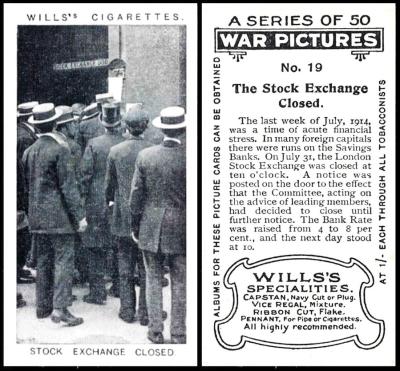
I thought this was rather an odd card to have in a military related set - it looks more suited to a set on London history, or banking.
However, in July 1914 it was already pretty certain to those in the know that we were heading towards a war, which, though fought in Europe, would affect Great Britain too. And in that month there was a sudden crisis, caused, mostly, by word of mouth and not fact. Many banks closed, including, as shown here, the London Stock Exchange, which, as one of, if not the most esteemed financial centre in the world, served to slump the banking world still more.
The Stock Exchange was closed for five months, starting on Friday the 31st of July. The Foreign Exchange had already shut, earlier in the week. And the banks had also rationed money, deciding to keep the gold coins safe in the vault and pay depositors in paper money. The smallest one of those at that time was a five pound note, but that was not easy to change, and so it became common practise to go to the Bank of England to change them, which also led to newspaper pictures that were wrongly reported as queues of people trying to get their money out.
The crisis was only eased when someone had a brainwave and printed smaller one pound notes. And they also printed advertisements that coaxed the general public into taking their sovereigns into their nearest bank and changing them for the new, lighter to carry, notes. This was actually a bit of a waste of effort, as few members of the general public had sovereigns just laying about. But reportedly it did inspire the middle and upper classes to do just that and it is thought that this was the main event which saved the banks, by restoring its gold stocks.
It was not until the seventh of July that the banks re-opened - and the Stock Exchange stayed shut until the fourth of January, 1915.
The set first appears in our original Wills reference book part three, RB.14 – which is more correctly known as "The Cigarette Card Issues of W.D. & H.O. Wills Parts I and II (revised) and Part III". This was edited by Edward Wharton-Tigar, and published in March 1949 as a limited edition of five hundred copies.
It is listed there as :
- 114. 50. WAR PICTURES. Fronts printed by letterpress in black and white; backs in black with descriptive text. Australian issues, 1915.
A. With "Wills`s Specialities" advertisement on backs.
B. With "Havelock" advertisement on backs.
There is actually a codicil to this, as in our original Wills reference book part four, RB.16 – which is more correctly known as "The Cigarette Card Issues of W.D. & H.O. Wills Parts I, II, and III (revised) and Part IV". Once more this was edited by Edward Wharton-Tigar, and published in 1950 as a limited Edition of five hundred copies. And what is revealed there is very interesting indeed, namely :
- 114. WAR PICTURES - see page 119.
The 50 subjects in this series are similar to those in Smith`s "War Incidents", 1st and 2nd Series".
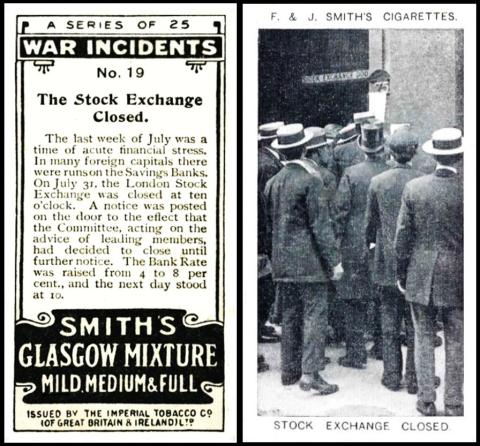
Thanks to a reader we can show you this actual card in the Smith`s version - or one of them, as the Smith`s set is vari-backed, with six permutations - advertising different brands. These are :
* Glasgow Mixture Mild Medium & Full
* "Orchestra" Cigarettes
* "Pinewood" Mixture
* Squaw Thick Black Tobacco
* "Studio" Cigarettes
* Sun Cured Mixture
Also note that this is two series simply because the Smith`s are each of twenty-five cards, whereas the Wills is a single set of fifty.
We also know that both the Smith and the Wills version were issued in 1915, but not the month of the Smith`s version. We only know the Wills month because when the five Wills books were reprinted under one hard cover they included a list of issue dates from the Wills "Works Magazine. This also proves that the Wills cards were printed in England, then shipped to Australia and issued there. And this means that only the Smith`s version would have been seen in Great Britain at the time, not the Wills.
Returning to the Wills versions, they next appear in our original World Tobacco Issues Index, recorded as :
- WAR PICTURES. Sm. Black and white. Nd. (50). See W/114 and H.405. ... W62-252
A. "Wills`s Specialities" back..
B. "Havelock" back. Brand issue.
This text is identical in the updated version of that volume, save the card code, which is now W675-385.A and W675-385.B
Tuesday, 26th August 2025
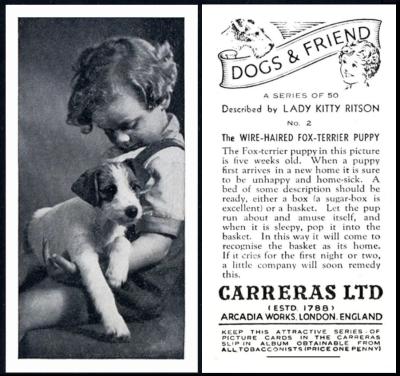
On the surface this is a pretty charming set with the small children and the dogs. I also like the way that the children are identified as being the friend of the dogs.
This dog will grow up to be a Wire-haired Fox terrier, which I am certain I have waxed lyrical about several times before - as the dog that walked beside the coffin of King Edward VII, as the canine star of "The Thin Man" series of movies, and as Tintin`s companion, Snowy, or Milou.
So instead lets chat about Lady Kitty Ritson, whose name appears on every card, because she described each dog. That was only one of her names, she was born Lady Kitty Edith Blanche Ogilvy on the 5th of February 1887, the daughter of the Countess of Airlie, who was a close friend of Queen Mary. Marriage, in 1906, to Berkeley Vincent, KBE CB CMG changed her name into Lady Kitty Vincent. He was older than her, by sixteen years, and a military man who had already served with honours in the China Expeditionary Force, the Second Boer War, the Russo-Japanese War and in Manchuria. They seem to have been very happy though, at first, and they had two children in 1911, but both of them died, aged just three in 1914. By the end of the decade, she had experienced more tragedy - losing both her brother, Patrick Julian Harry Stanley Ogilvy MC, Hon. Captain of the 1st Battalion of the Irish Guards, who was killed in action in 1917, and her sister Lady Mabel Griselda Ashley Sudley Ogilvy, who reportedly died after an accident, in 1918, which occurred whilst she was exercising horses for the Army. However I have not been able to verify this, and her name appears on the Nursing Memorial in London, so it is hard to see that she was both a nurse and a horse-exerciser. But it intrigues me so I will keep digging.
The Vincent marriage broke up in 1925, and the following year our lady married again, to Ralph Gerald Ritson, a Newcastle man, seven years older than her. There were no children from this marriage, perhaps she could not bear another loss.
Today we chiefly know our lady for the pony books she wrote for children, under her second husband`s name of Lady Kitty Ritson - though she also went on to write more learned articles about horsemanship and equitation for magazines, and was an early influencer for the adoption of Western riding techniques and skills. Her first pony book, "A Kiss for Kara" was written in 1939, and it seems very little known today, only that it was a blend of romance and riding - not a great combination as, and I should know, pony-mad children are not the slightest bit interested in romance, or boys, so they just skim over those parts, flicking the pages merrily until they get back to the juicy bits about the riding and the gymkhanas.
These cards show another facet of her character, as she was even more prominent in the dog world, as a judge and author, and we can also thank her for the popularity of many Scandinavian breeds, including the Norwegian Elkhound and the Finnish Spitz.
Apart from that, though, she was also involved with Guide Dogs for the Blind. That story also deserves to be told, for it was an American, Mrs. D. Harrison Eustis, who saw the work with seeing-eye dogs that was being done in Germany and set up a training centre in Wallasey with four guide dogs, who were taught to cater to their owners needs. Two other women then got involved, Mrs Rosamund Bond and Miss Muriel Crooke, both of whom were enthusiasts of the German Shepherd breed. Then, in 1931, two other supporters came forward, one of these was Captain Alan Sington, and the other one was our Lady Kitty Ritson. Having a military man and a titled lady on board was sufficient to raise the profile of the group, and they were then able to get a meeting with the Royal National Institute for the Blind.
Eventually our lady rose to be a Vice President of The Guide Dogs for the Blind Association, along with Mrs. Bond and Miss Crooke. And Mrs. Eustis became a Vice-Patron.
She died on the seventeenth of October, 1969.
The set first appears in our original World Tobacco Issues Index, but very scantly described as :
- DOGS AND FRIEND. Sm. Black and white. Nd. (50). ... C18-40
And its the same text in our updated World Tobacco Issues Index, just changing the card code to C151-235
Wednesday, 27th August 2025
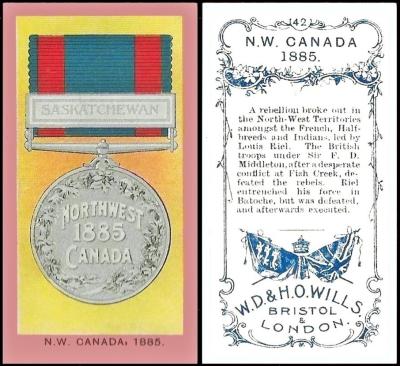
This is rather an unusual medal, and I have had this scan on disc for some time, since we had the Mounties as our theme of the week - for this is the North West Canada Medal, issued by the British Government to the soldiers, volunteers, and members of that North West Mounted Police force, to mark their participation in the North West Rebellion of 1885.
However, at first, the North West Mounted Police were left off the roll, and it was not until December 1886, after much discussion, that their medals were awarded. This was some exercise, as almost a thousand extra medals had to be struck - perhaps the reason why they were not included in the first place, though the officials insisted they were not awarded because they were not British, and part of an organised, non-military force. Another sticking point was that the medal was not just a medal, it came with either a cash payment of eighty dollars, or three hundred and twenty acres of land. And, for whatever reason, this part of the settlement was never granted to the men of the North West Mounted Police.
The bar, "Saskatchewan" was an additional award, and only given to men who took part in either the battles of Batoche, Cut Knife, Fish Creek, and Frenchman`s Butte. There was also grumbling about this, as the men felt that a separate clasp ought to have been issued for each action, though, as was found in the Crimea, adding a bar for every action made the medal almost too heavy to wear.
The sad thing about this medal is that the same one was issued to all, and none of them were ever engraved officially around the rim. So unless they had them engraved off their own bat and out of their own purse, as the men passed on, and their families too, all we have is a medal, but no idea of the personal story behind it and no way to research it either.
There are several versions of this set, and to read about the others, nip along to our Card of the Day for the 23rd of October 2023.
Today we get to chat about the Wills version, which is first described in our original reference book RB.11, "The Cigarette Card Issues of W.D. & H.O. Wills Part I (revised) and Part II", edited by Edward Wharton-Tigar and published in 1948. That entry reads :
- 25. 50. MEDALS (untitled).
Fronts : Medals on coloured background, with pinkish border (considerable variation in shade). Details of medal at foot. Backs in blue, with texts.
Cards can be collected on two types of board (a) white, surfaced (b) grey-white, matt. Cards of type (a) are thicker than type (b).
Card No.50 depicts the South African War Medal 1901-2; the backs of the cards do not include the limited liability indication or I.T.C. Clause. The series thus presumably belongs to the transition period, 1902-3, and was intended for export brands Similar, but not identical series issued by Churchman, Imperial Tobacco Co., and Smith.
This is updated in RB.19, "The Cigarette Card Issues of W.D. & H.O. Wills Parts I to IV (revised) and Part V", which was published in 1951. That entry adds no knowledge about the printing or subjects, it simply reads :
- 25. MEDALS - see page 68.
This series was issued abroad in September 1905.
When the five Wills booklets were reprinted under one hard cover, a list of dates of issue was included, which was supplied to us by Messrs, W.D. & H.O. Wills and had been printed in their "Works Magazine". This reveals that this set was printed in Great Britain and shipped abroad for circulation, rather than being printed locally. However it is only the second set on that list, and the first is "Russo-Japanese Series", issued not too much earlier in June 1905. Then there is a gap of exactly a year before the printing of "Wild Animals of the World" with the two large leaves, three flowers, and Star and Circle back, in green, was issued, in India, in September 1906
By the time of our original World Tobacco Issues Index, the set is rather hidden under section 5 of the Wills issues, devoted to "Other Export Issues". The header for section A, which includes this set, tells us that the sets in that group were issued through B.A.T. , chiefly in the Channel Islands, Malta, India, and Malaya. The entry reads :
- MEDALS (A), Sm. Nd. (50). See W/25 and H.71. ... W62-419
This text remains the same in our updated World Tobacco Issues Index, but there is a new card code, of W675-594
The reference to H.71 is our accompanying handbook, and most of it pertains to the Smith`s issues, but I have extracted the relevant facts about the Wills version for here, which are that "The Wills set was prepared for issue in India, and a number of the original subjects were replaced with medals of Indian interest. At the same time the Edward Transvaal Medal was moved to No.50."
It lists the set as :
- Wills - Series of 50. Numbered. Subjects as Churchman
A. White card
B. Toned card
Thursday, 28th August 2025
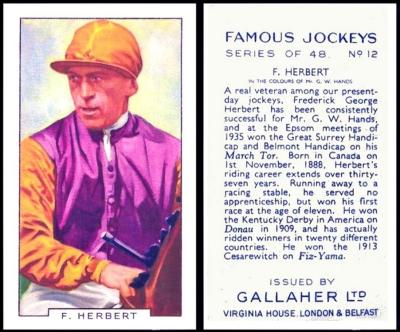
Today`s jockey is Robert Frederick "Fred" George Herbert, and, as this card tells us, he was born on November the first, 1887, in Canada - though it was actually in Hamilton, Ontario.
He is recorded as having started as a performer, specialising in acrobatics, and, according to many sources, at one time was in a group of fellow acrobats but then he decided he liked racing better. However, other sources skip the acrobatics - and our card backs this up, telling us that "running away to a racing stable, he served no apprenticeship, but won his first race at the age of eleven".
I am not sure what that race was, but we do know it was in May 1899, and took place in Kentucky.
As far as his first major prize, that was also in Kentucky; the Kentucky Derby of 1910. It was doubly notable because he was the first Canadian to ever win that race. However he was not a full Canadian, as his father was born in Manchester, England.
He may have gone on to better things, but in 1912, the Hart-Agnew Anti-Betting laws came into effect, and that pretty much ended horse racing in America.
It appears that after the First World War he picked up a patronage from the renowned Whitney family, who helped him move to England, where they had a large stable at Newbury. His greatest win over here was the Cesarewitch of 1913, which is even mentioned on our card, as his mount was "Fiz Yama", nowhere near the favourite, his odds were actually 50-1, but he came from nowhere to beat the field by a head, with the favourite only fourth. And the two were teamed together again at Epsom in 1915, winning the Great Metropolitan Handicap.
He also seems to have had an association with G W. Hands, and he is mentioned on our card too, quoting wins at Epsom in 1935. Mr. Sands is a very interesting character, an American, born in 1871 in Bridgeport, whose family moved to Birmingham when he was only nine. From there he became very interested in engineering and mechanics, starting out making bicycles and eventually ending up owning The Calthorpe Motor Co and the G.W. Hands Motor Co, as well as managing the Palace Hotel in Torquay.
Returning to out man, he retired on his sixty-first birthday, and rode the same day, at Hurst Park. And he died in Maidenhead in June 1955, aged sixty eight.
This set first appears in our original Gallaher reference book RB.4, published in 1944, and edited by Eric Gurd as :
- 1936. FAMOUS JOCKEYS (titled series). Size 2 1/2" x 1 7/16". Numbered 1-48. Fronts, printed in full colour by offset-litho, black frame lines, white margins, subjects titled. Backs printed in (a) dark blue (b) violet blue, with descriptions and "Issued by Gallaher Ltd. Virginia House, London & Belfast". Printed by E. & S.A. Robinson, Ltd., Bristol.
By the time of our original World Tobacco Issues Index, this has been shortened, quite considerably, to :
- FAMOUS JOCKEYS. Sm. Nd. (48) ... G12-83
You will notice that no mention is made of the shade variation, so I presumed that it was decided that the violet was simply a variation in the ink, and struck from record. However, in our updated World Tobacco Issues Index the entry reads as follows :
- FAMOUS JOCKEYS. Sm. Back in (a) blue (b) mauve. Nd. (48) ... G075-590
I think today`s Card of the Day is almost certainly blue, but if someone has it in the violet or mauve colourway perhaps you could let us know so we can compare notes, thanks in advance.
Friday, 29th August 2025
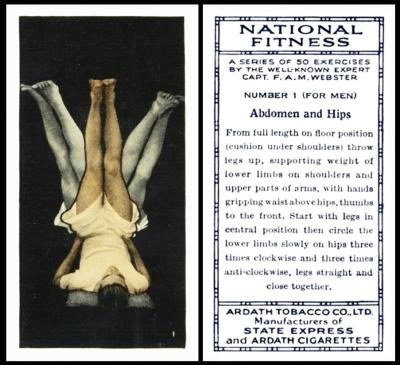
I have to say that there is not much to describe as to the subject on this card, except that the idea of one man with six legs is rather alarming. So instead of that I will turn the card over and speak of what follows the title, which is that these cards were "A series of 50 exercises by the well-known expert Capt. F.A.M. Webster".
Frederick Annesley Michael Webster was a British Army captain, who worked for the Intelligence Corps during the First World War, and because of that we will probably never know what he did for them, most of it will always remain secret.
We do know that he was born on the twenty-seventh of June, 1886, in St Albans, an only child, and that his father was a surgeon. However when he was almost eleven years old, his father died, and his mother was left to raise him alone. He went to school in St. Albans, and quickly became involved with sport, all kinds, but especially football and cricket. He was a keen player, but tended to be impetuous, and want to go for every chance. It seems to have been decided that team games were not his thing, and so he was asked to try out for the athletics squad. He took to this straight away and won almost every race that was ever held during his time at the school.
He left in 1904, when he was eighteen, and joined what today we would consider the Territorial Army, the 2nd Battalion of the Bedfordshire Regiment. He also started work as an accountant and surveyor, but continued to compete in athletics, both at his old school and open events held in his local or at least reachable area. We know he cycled, as he was part of the Cyclists Section of his Regiment, and this is possibly how he got to the more rural events.
He also wrote about sport, including the 1908 Olympics, which were held at White City. These led to the formation of the Amateur Field Events Association, in 1910, with another man heavily involved in the 1908 Olympics, Arthur Conan Doyle, who became the Chairman, our man becoming Secretary.
The two men got on very well and it is almost certain that Arthur Conan Doyle shared ideas for his stories with our man, and probably also encouraged him, directly, or indirectly to write. At first Mr. Webster`s writing took the form of non-fiction, with several books and treatises about athletics and how to play sports, which were published under his own name, to much acclaim. And he may have continued in this vein if it were not for the outbreak of the First World War.
As he was already serving in the T.A., or its equivalent, he was straight away called up. He seems to have done some soldiering, and also written for the military, for his name appears on an official publication called "The Volunteer Training Handbook", published in 1915. This was obviously aimed at the non-military men who were coming forward to fight from a variety of sources, rather than the military`s own.
Yet in 1915 he was, strangely, listed as being unfit for general service. It is supposed that this was due to a knee injury that he sustained whilst playing football three years prior in a game at his old school, but there is no real evidence that this would have presented any form of active service, and he would have been an officer, more likely to command from base than ever visit the trenches let along fight amongst them. We also know that he was opposed to the decision, and kept trying to be sent overseas to see some action. Eventually this worked, and he was sent out to East Africa, where the war had pretty much all finished; however we know that after hostilities finally ceased he was re-examined, for re-assignment for another military posting, but he was again pronounced unfit.
Instead he came home and was reunited with his wife and three children, who had all been born during the war. To occupy his time, he decided to return to writing, but to have a go at non-fiction. He did not know how well this would go down, and so he wrote under an assumed name, of Michael Annesley, his two middle names reversed. His first novel drew much of its inspiration from Arthur Conan Doyle`s 1902 book "The Hound of the Baskervilles" - it was even called "The Hound of Cullen", but it was set in Ireland, not Dartmoor, and it was published in 1918. It seems likely that his later fiction was also derived from remembered conversations with Arthur Conan Doyle, as several of the other books concerned apes, or ape-like men, and their battles to civilise and tame the humans, often with much conflict, which is redolent of "The Lost World", published in 1912, though there is also something of a similarity to Edgar Rice Burroughs "Tarzan" stories, first published in 1912 as well. And then there was a series which revolved around a female who rules over men, which seems to have been modelled on H. Rider Haggard`s "She, a History of Adventure, published in 1886.
If published today we would classify a lot of his work under the heading of young adult science fiction, but at the time it was aimed at actual adults, which is perhaps more a reflection of our times than his.
His last novel was intended to be along those lines as well, it was called "The Trail of the Skull" and published in 1937. He then went back to the Army, where he was sequestered to the Army Physical Training Corps. However in 1950, a year after his death, a new book appeared. This was called "The Land of Forgotten Women", and it appears that the text of this was found amongst his effects.
By the way, you may be interested to know that one of his sons, Dick, was also athletic, but specialised in the pole vault - so much so that he represented Great Britain at the 1928 Amsterdam Olympic Games, and the 1936 Berlin ones, where he finished in sixth place.
On the surface this appears to simply be a set encouraging exercise, but look at the date and you will realise it is more an attempt to build a fit, fighting force, as events in Europe seem to be escalating towards a Second World War.
Our original Ardath reference book, RB.6, published in 1943, when the war that had been feared had become reality, catalogues the set, or sets, as :
- Sept. 1938. 50. NATIONAL FITNESS (titled series). (Reproductions of exercises by Capt. F. A. M. Webster.) Size 1 7/16" x 2 11/16". Nos. 1-34 for men and 35-50 for women. Printed in 2 colours from half-tone blocks, untitled, black backgrounds, white margins. Numbered on front as well as on back. Backs printed in bronze blue, with descriptions, adhesive, varnished. Issued with State Express and Ardath Cigarettes. Also issued to H.M. Ships and abroad.
- Aug, 1938. 50. NATIONAL FITNESS. As above but not adhesive. Issued in New Zealand.
I was surprised to learn it was not just available in two formats, but also issued overseas, or at least in New Zealand, and circulated there before it was brought over here. Why New Zealand was given it first I have no idea, and it gets even more curious when you find out that the Navy, or other overseas countries, were not given it at the same time as New Zealand.
Now when this set appeared in our original World Tobacco Index, this rather lengthy description had been curtailed, to just :
- NATIONAL FITNESS. Sm. Nd. (50) ... A72-32
A. Adhesive back. Home issue
B. Non-adhesive back. Export issue.
And this is the same entry in our updated version of that book, save a new card code, of A745-440
And so another newsletter draws to a close.
I touched, at the start of this, that it had been a difficult week, and it has been worse than that. I am also not sure it may get better for some time. I am well, in a physical sense, but I am going to need to take some time off.
However I am adamant that the newsletter will continue, and the website too, though the way it is done may have to temporarily alter. We have a huge amount of amazing cards that are only in the newsletters, and really deserve better featuring as a Card of the Day, and that is one idea as to how things may continue.
But if anyone has any other ideas for possible changes, please do get in touch at webmaster@card-world.co.uk
So to those of you who I came to know by name or pseudonym, and those who supplied ideas or cards for the theme of the week, I thank you. But I also thank those of you who just came along and read, without ever stepping out of the shadows and saying who you were.
